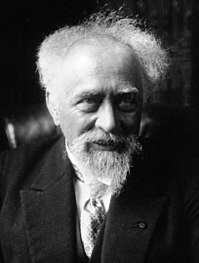Jean Baptiste Perrin Obras | Referências Ligações externas | Menu de navegação«Jean Baptiste Perrin. 1870-1942»10.1098/rsbm.1943.0004Jean Baptiste PerrinPerfil no sítio oficial do Nobel de Física 1926eeexpandindo-oWorldCat100204026ADV1100213890601199XX96561912174393p2332574ID2017780050468118790412IDn8710391900652475skuk000107735090343000099423069162557n2002097612113891w6v420jw030298857OL2265276A000486011
Nascidos em 1870Mortos em 1942Nobel de FísicaLaureados com o Nobel por país - FrançaMembros da Academia de Ciências da FrançaMembros estrangeiros da Royal SocietyConferência de SolvayFísico-químicos da FrançaFísicos da FrançaAlunos da Universidade de ParisAlunos da Escola Normal Superior de ParisSepultados no Panteão (Paris)Naturais de Lille
Lille30 de setembro1870Nova Iorque17 de abril1942físicofrancêsNobel de FísicaConferência de Solvay
Jean Baptiste Perrin | |
|---|---|
 | |
| Nascimento | 30 de setembro de 1870 Lille |
| Morte | 17 de abril de 1942 (71 anos) Nova Iorque |
| Nacionalidade | Francês |
Alma mater | Escola Normal Superior de Paris |
| Prêmios | Medalha Matteucci (1911), Prix La Caze (1914), |
| Instituições | Escola Normal Superior de Paris, Universidade de Paris |
| Campo(s) | Física |
Jean Baptiste Perrin ForMemRS[1] (Lille, 30 de setembro de 1870 — Nova Iorque, 17 de abril de 1942) foi um físico francês.
Recebeu em 1926 o Nobel de Física, por estudos sobre a estrutura descontínua da matéria e, em especial, pela descoberta do equilíbrio na sedimentação.